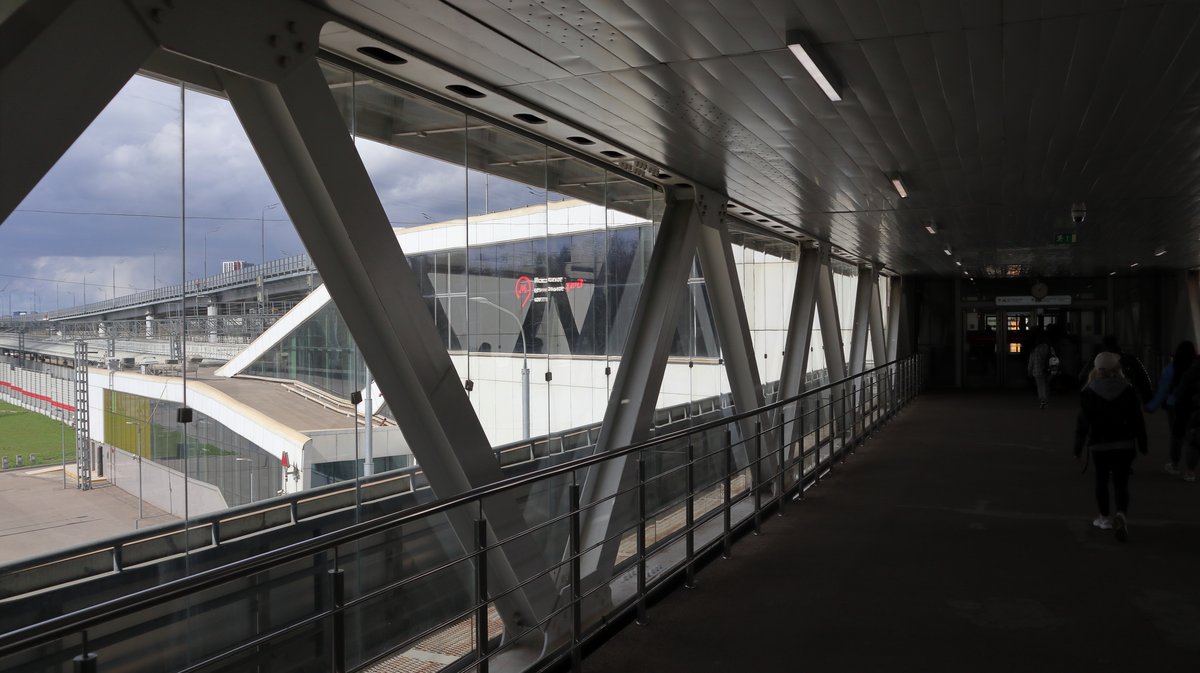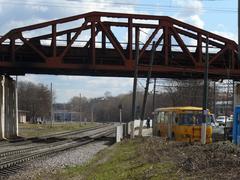
Okruzhnaya Moscow Historical Site: Visiting Hours, Tickets, and Tourist Guide
Date: 14/06/2025
Introduction to Okruzhnaya Historical Site in Moscow
Located in the northern sector of Moscow, Okruzhnaya stands out as a multifaceted district that seamlessly integrates its industrial heritage with ongoing urban renewal. From its early 20th-century role as part of the Moscow Little Ring Railway to its present status as a vital interchange within the city’s transport network, Okruzhnaya offers visitors a unique perspective on Moscow’s evolution. While it is not a conventional tourist destination, the district provides authentic glimpses into local life, convenient access to green spaces like Timiryazevsky Park, and a chance to experience Moscow’s dynamic urban landscape away from the primary tourist trails. This guide covers Okruzhnaya’s rich history, modern infrastructure, transport connections, practical visitor information, safety, accessibility, nearby attractions, and key travel tips. To enhance your experience, consult official sources such as the Moscow Metro, Moscow Transport, and the city’s Master Plan 2025.
Contents
- Introduction
- Historical Evolution of Okruzhnaya
- Early Development and Soviet Era
- Post-Soviet Transformation and Modernization
- Urban Development and Infrastructure
- Transportation Networks and Connections
- Residential and Commercial Growth
- Green Spaces and Public Amenities
- Okruzhnaya’s Significance in Moscow
- Strategic Location and Connectivity
- Urban Renewal and Socioeconomic Impact
- Cultural and Community Life
- Visitor Information
- Getting There and Around
- Accommodation and Dining
- Safety and Local Etiquette
- Accessibility for Disabled Visitors
- Photographic Spots and Events
- FAQ
- Conclusion
- Visual Resources and References
Historical Evolution of Okruzhnaya
Early Development and Soviet Era
Okruzhnaya derives its name from the Russian word for “circular,” referencing its position alongside the Moscow Circular Railway (now the Moscow Central Circle, MCC). Established between 1903 and 1908, the Okruzhnaya railway station was integral to the Moscow Little Ring Railway, initially serving freight to alleviate congestion in central Moscow. During the Soviet era, the area expanded as an industrial and logistics hub, with factories, warehouses, and worker housing shaping its urban character (Official Moscow Transport Site).
Post-Soviet Transformation and Modernization
Following the dissolution of the Soviet Union in 1991, Okruzhnaya underwent significant transformation. Industrial facilities were repurposed or redeveloped, aligning with Moscow’s urban expansion. The 2016 relaunch of the Moscow Central Circle for passenger service greatly enhanced Okruzhnaya’s connectivity (Moscow Metro Official). Guided by the city’s “Master Plan 2025,” the district now features modern residential complexes, business centers, and revitalized green spaces (Moscow Urban Planning Committee).
Urban Development and Infrastructure
Transportation Networks and Connections
Okruzhnaya serves as a major interchange, connected by the Moscow Central Circle (Line 14), the Lyublinsko–Dmitrovskaya Metro Line (Line 10), and the Moscow Central Diameters (MCD). The area’s integration into Moscow’s public transport system allows seamless transfers between metro, suburban rail, buses, and trams, making it a strategic node for commuters and travelers (Moscow Metro Map).
Adjacent to the Third Ring Road, Okruzhnaya also facilitates easy road travel throughout Moscow.
Residential and Commercial Growth
The district’s urban landscape blends Soviet-era apartment blocks with contemporary high-rises, retail centers, and landscaped communal areas. This diverse setting attracts longtime residents and young professionals alike. Commercial expansion along major avenues has resulted in new offices, shopping centers, and services, supporting a lively, walkable neighborhood (Moscow’s Master Plan 2025).
Green Spaces and Public Amenities
Green spaces like Timiryazevsky Park provide extensive trails, playgrounds, and areas for recreation, reflecting Moscow’s commitment to accessible public amenities. Upgrades in schools, health centers, and other services further support the district’s residents.
Okruzhnaya’s Significance in Moscow
Strategic Location and Connectivity
Okruzhnaya’s location at key transport intersections makes it a gateway between central Moscow and its northern suburbs. Its accessibility fosters economic growth and attracts businesses seeking high commuter traffic.
Urban Renewal and Socioeconomic Impact
Redevelopment of former industrial areas has revitalized Okruzhnaya, drawing young families and professionals. Modern housing, job creation, and environmental improvements are evidence of Moscow’s broader shift toward service-oriented, sustainable urban development.
Cultural and Community Life
Okruzhnaya is home to a multicultural population that supports a vibrant community life. Local markets, cafes, and cultural centers offer social spaces, while open-air festivals and sporting events encourage neighborhood engagement.
Visitor Information
Getting There and Around
Okruzhnaya is easily accessible via the Moscow Metro and the MCC. From Sheremetyevo International Airport, take the Aeroexpress to Savyolovsky Station, then transfer to the metro or MCC (Moscow Airport Guide). Public transit is efficient, with tickets and multi-day passes available at stations or via mobile apps. Taxis and ride-hailing apps such as Yandex.Taxi are alternatives, though rush hour may cause delays.
Accommodation and Dining
While Okruzhnaya itself is primarily residential, nearby districts like Begovoy and Timiryazevsky offer a range of accommodations, from budget hotels to serviced apartments (Best Areas to Stay in Moscow). Dining options include local cafes and restaurants serving Russian and international cuisine; for more variety, explore adjacent neighborhoods.
Safety and Local Etiquette
The district is considered safe, with visible police presence and well-maintained spaces. Remain vigilant in crowded areas and use anti-theft bags. English is less common outside tourist zones—learning basic Russian phrases is helpful. Dress modestly at religious sites, keep noise levels down in residential areas, and follow tipping customs (about 10%). Credit cards are widely accepted, but carrying some cash is useful.
Accessibility for Disabled Visitors
Okruzhnaya’s stations offer elevators and ramps, but older infrastructure may present challenges. Check the Moscow Metro Official Site for detailed accessibility information.
Recommended Photographic Spots and Events
Photographers can capture the modern architecture of Okruzhnaya station, passing MCC trains, and the greenery of Timiryazevsky Park. Seasonal events such as festivals and sports competitions provide lively photo opportunities and a window into local life.
Visiting Hours and Ticket Information
- Okruzhnaya Station: Open daily from 5:30 AM to 1:00 AM.
- Tickets: A single ride costs about 60 rubles (2025), valid across the metro, MCC, and MCD, with free transfers within 90 minutes. The Troika card offers convenient, contactless payment for all public transit.
- Purchasing: Tickets can be bought at kiosks, vending machines, or online. Contactless payments via phone or bank card are accepted.
- Travel Tip: Download the official Moscow Transport app for real-time updates and bilingual metro maps.
Safety Considerations
Moscow, including Okruzhnaya, is generally safe for tourists (Hikersbay). Violent crime is rare, but be alert for pickpockets in crowded areas. Use licensed taxis or ride-hailing apps to avoid scams (Wander Without Wheels). Dress warmly in winter and plan for icy conditions.
Accessibility and Transport
Okruzhnaya is a key transport hub with metro, MCC, buses, trams, and suburban trains. The Troika Card provides discounted fares across all public transit. Many stations are equipped with elevators and tactile paving, improving accessibility (BCG Report). Use navigation apps like Yandex.Metro for real-time directions.
Cultural Insights and Local Life
Okruzhnaya offers insight into authentic Moscow life, with local markets, neighborhood cafes, and green spaces. English is less common—learn a few Russian phrases or use translation apps. Neighborhood etiquette includes respectful greetings, neat dress, and modesty in public spaces. Major Moscow festivals, such as Maslenitsa and Tea Party Festival, are easily accessible via metro (ETS Russia Travel).
Nearby Attractions
- Timiryazevsky Park: Extensive green space for walking, picnics, and relaxation.
- Ostankino Tower: One of the world’s tallest TV towers, offering panoramic views and a rotating restaurant (ostankino.ru).
- VDNKh Exhibition Center: Soviet-era pavilions and exhibitions about science, culture, and history.
Practical Travel Tips
- Best Time to Visit: Spring through early autumn for pleasant weather.
- Currency: Russian Ruble (RUB); cards are widely accepted.
- Wi-Fi: Available in most metro stations and public spaces.
- Emergency Numbers: Police 102, Ambulance 103.
- Healthcare: High-quality but expensive for foreigners; travel insurance recommended.
Frequently Asked Questions (FAQ)
Q: How do I get to Okruzhnaya from Sheremetyevo Airport?
A: Take the Aeroexpress to Savyolovsky Station, then transfer to the metro or MCC.
Q: What are the Okruzhnaya metro station visiting hours?
A: Daily from 5:30 AM to 1:00 AM.
Q: Is the area safe for solo travelers?
A: Yes, but take standard precautions as in any large city.
Q: Are there ticket fees for entering Okruzhnaya?
A: No entry fee; transport fares apply.
Q: What nearby historical sites can I visit?
A: Timiryazevsky Park, Ostankino Tower, and central Moscow’s major attractions via metro.
Visual Resources
Alt text: Okruzhnaya Station entrance with clear signage in Moscow.
Alt text: Moscow Metro map showing Okruzhnaya station as a transfer hub.
Conclusion
Okruzhnaya exemplifies Moscow’s capacity to blend its industrial roots with forward-looking urban development. As a gateway to northern neighborhoods and a living narrative of ongoing transformation, Okruzhnaya offers visitors a genuine Moscow experience—safe, accessible, and culturally enriching. Maximize your trip by leveraging digital tools like the Audiala app, and consult official resources for up-to-date travel information.
Sources and Further Reading
- Official Moscow Transport Site
- Moscow Metro Official
- Moscow City Tourism
- Moscow Urban Planning Committee, Master Plan 2025
- Wikipedia: Moscow Central Circle
- Best Areas to Stay in Moscow
- Hikersbay
- The Broke Backpacker
- Wander Without Wheels
- ETS Russia Travel
- ostankino.ru
- BCG Report





















































































































































































































































































